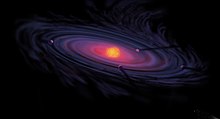It is not known with certainty how planets are formed. The prevailing theory is that they are formed during the collapse of a nebula into a thin disk of gas and dust. A protostar forms at the core, surrounded by a rotating protoplanetary disk. Through accretion (a process of sticky collision) dust particles in the disk steadily accumulate mass to form ever-larger bodies. Local concentrations of mass known as planetesimals form, and these accelerate the accretion process by drawing in additional material by their gravitational attraction. These concentrations become ever denser until they collapse inward under gravity to form protoplanets. After a planet reaches a diameter larger than the Earth's moon, it begins to accumulate an extended atmosphere, greatly increasing the capture rate of the planetesimals by means of atmospheric drag.
When the protostar has grown such that it ignites to form a star, the surviving disk is removed from the inside outward by photoevaporation, the solar wind, Poynting-Robertson drag and other effects. Thereafter there still may be many protoplanets orbiting the star or each other, but over time many will collide, either to form a single larger planet or release material for other larger protoplanets or planets to absorb. Those objects that have become massive enough will capture most matter in their orbital neighbourhoods to become planets. Meanwhile, protoplanets that have avoided collisions may become natural satellites of planets through a process of gravitational capture, or remain in belts of other objects to become either dwarf planets or small Solar System bodies.
The energetic impacts of the smaller planetesimals (as well as radioactive decay) will heat up the growing planet, causing it to at least partially melt. The interior of the planet begins to differentiate by mass, developing a denser core. Smaller terrestrial planets lose most of their atmospheres because of this accretion, but the lost gases can be replaced by outgassing from the mantle and from the subsequent impact of comets. (Smaller planets will lose any atmosphere they gain through various escape mechanisms.)
With the discovery and observation of planetary systems around stars other than our own, it is becoming possible to elaborate, revise or even replace this account. The level of metallicity – an astronomical term describing the abundance of chemical elements with an atomic number greater than 2 (helium) – is now believed to determine the likelihood that a star will have planets. Hence, it is thought that a metal-rich population I star will likely possess a more substantial planetary system than a metal-poor, population II star.
Decline
-
Rampant inflation, border incursions and manpower shortages during the
third century CE led to increasing military demands on the Imperial purse,
from whic...
14 years ago

0 comments:
Post a Comment